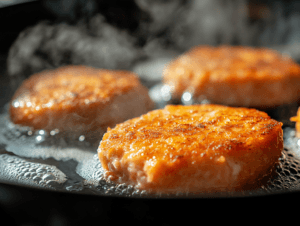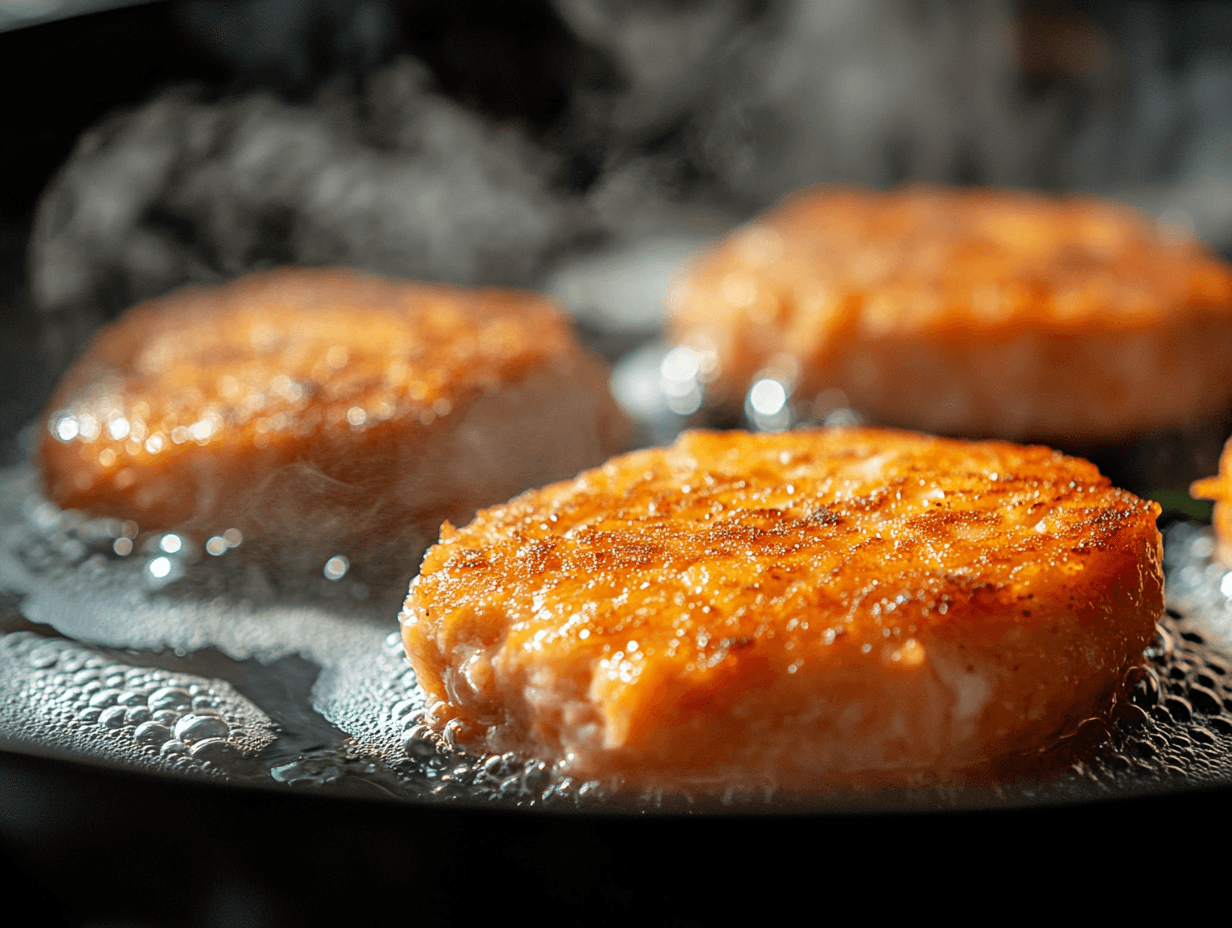Salmon patties are a delicious, versatile dish, but nothing is more frustrating than cutting into one and finding it mushy inside. If you’ve been asking, “Why are my salmon patties mushy inside?”—don’t worry! You’re not alone. This guide will show you exactly how to fix soggy patties and create perfectly firm, flavorful results every time.
Table of Contents
Understanding Salmon Patties: A Culinary Delight
What Makes Salmon Patties Unique?
Salmon patties (or salmon cakes) are beloved for their simplicity and versatility. Made with cooked or canned salmon, mixed with a blend of binders and seasonings, and then fried to golden perfection, they’re a go-to comfort food. What makes them even better? They’re quick, nutritious, and can be customized to fit your taste.
But here’s the thing—getting the texture right is tricky. You want a patty that holds its shape, has a slight crisp, and doesn’t crumble or feel too soft inside.
Common Cooking Challenges with Salmon Patties
If you’ve faced issues like patties falling apart, being too wet, or ending up mushy, you’re not alone. These are the most common complaints from home cooks. Why does this happen? The answer lies in your preparation and cooking techniques. But hey, don’t beat yourself up—salmon patties are more science than art!
“Cooking is like chemistry—you need the right ingredients in just the right amounts to get things perfect.”
The Science Behind Mushy Salmon Patties
Cooking salmon patties is more than tossing ingredients together and frying them up. There’s real science behind achieving that perfect balance of texture and taste. Let’s explore how moisture, binding agents, and cooking techniques influence the outcome of your patties.
Moisture Content in Salmon: A Balancing Act
Salmon is naturally moist, which is great for flavor and tenderness. However, there’s a fine line between just enough moisture for a juicy patty and too much that makes it mushy. Both canned and fresh salmon have unique challenges when it comes to controlling moisture.
- Canned Salmon: While convenient, canned salmon is often packed in water or oil, which adds unnecessary liquid to your mix. Always drain canned salmon thoroughly using the lid to press out excess liquid. If it still feels overly wet, gently pat it dry with a paper towel.
- Fresh Salmon: Freshly poached or baked salmon can retain water, especially if cooked with steam or covered. To minimize excess moisture, let the salmon cool slightly, then use a paper towel to blot away any remaining liquid before flaking it.
Why does this matter?
Excess moisture dilutes the flavor of your seasonings and makes it difficult for the patties to hold their shape. This results in a mushy texture that no one wants. Imagine trying to build a sandcastle with wet sand—it just collapses. The same principle applies here.
“Great patties are about balance—too much or too little moisture can ruin the texture and leave you disappointed.”
How Binding Agents Affect Texture
Binding agents are the unsung heroes of salmon patties. Think of them as the glue that holds your masterpiece together. Without them, your patty would fall apart faster than a poorly built sandcastle. The key is finding the right binder and using it in the correct proportion.
- Eggs: Eggs add both moisture and structure, but too much egg can overpower the mixture and make it slimy. Stick to one egg per pound of salmon for a balanced result.
- Breadcrumbs: These are the go-to binder for salmon patties, absorbing excess moisture while providing a firm yet light texture. For an extra crunch, panko breadcrumbs are an excellent choice.
- Mashed Potatoes: Want something different? Mashed potatoes are a creamy binder that adds a subtle richness. Be careful not to use overly soft or watery potatoes, as they can contribute to a mushy texture.
The golden ratio? Start with equal parts salmon and binder, then tweak based on how wet or dry your mixture feels. Always mix gently to keep the texture light and airy.
Pro Tip: “When in doubt, test one patty before cooking the whole batch. That way, you can adjust your binder ratio as needed.”
The Role of Cooking Techniques in Firmness
Even with the perfect mixture, the way you cook your patties plays a huge role in determining their texture. Cooking salmon patties is all about achieving balance—too much heat or too little can turn a great recipe into a culinary flop.
- Heat Level: Medium heat is your best friend. Too low, and your patties will steam instead of frying, trapping moisture inside and leaving the centers soft. Too high, and the outside burns before the insides have time to cook through.
- Preheating: Always preheat your skillet before adding the patties. A well-heated pan ensures the surface of the patties crisps up instantly, sealing in the juices and preventing them from soaking up oil.
- Cooking Time: Cook each side for about 3–4 minutes. This gives the patties enough time to develop a golden crust while cooking evenly inside. Avoid pressing the patties with your spatula—it squeezes out the moisture you worked so hard to control.
“Cooking is like storytelling—each step builds on the last to create something unforgettable.”
By mastering these three factors—moisture, binders, and cooking techniques—you’ll take your salmon patties from soggy to sensational. Ready to put these tips to the test? Your taste buds will thank you!
“Perfect patties are like a good book—they need balance, structure, and just the right amount of heat to keep things interesting.”
You can also check out our Old-Fashioned Salmon Patties Recipe: A Classic Dish Revisited for a tried-and-true recipe.
Identifying the Causes of Mushy Salmon Patties
Achieving the perfect salmon patty means avoiding a few common pitfalls. Mushiness is often the result of small mistakes, but once you know what to look for, it’s easy to fix. Let’s explore the most frequent culprits.
Improper Use of Binders
Binders are the glue that holds your salmon patties together. Without them, the mixture is unstable—like trying to build a house without cement. But there’s a catch: you need just the right amount.
Using too much mayo or egg can make the mixture overly wet and sticky, creating a soft, mushy patty. On the other hand, skimping on dry binders like breadcrumbs or crushed crackers leaves the patties loose and prone to falling apart.
The key? Start with a small amount of binder and gradually add more until the mixture holds its shape. A balance between wet and dry binders ensures structure without sacrificing moisture.
Excess Liquid in the Mixture
Liquid is one of the sneakiest culprits behind mushy patties. Even small amounts can throw off the texture. Common culprits include undrained canned salmon and ingredients like lemon juice, sauces, or chopped vegetables that release moisture as they cook.
To prevent this:
- Always drain canned salmon thoroughly, pressing out as much liquid as possible.
- When using fresh salmon, pat it dry after cooking and before mixing.
- Be mindful of adding wet ingredients like mayo or mustard—start small and adjust based on the texture.
Tip: If your mixture feels too wet, adding a tablespoon of breadcrumbs at a time can help soak up the excess liquid.
Inadequate Cooking Temperatures
Cooking at the wrong temperature is an often-overlooked cause of mushy salmon patties. Low heat might seem like a gentle, safe approach, but it prevents the patties from forming a crispy crust. Without that crust, moisture gets trapped inside, leading to a soft and undercooked texture.
Instead, aim for medium heat. Preheating your skillet ensures the patties sear quickly, creating a barrier that locks in moisture while cooking the inside evenly. It’s also important not to overcrowd the pan, as this lowers the overall temperature and prevents proper browning.
Pro Tip: Avoid flipping the patties too soon. Let them cook undisturbed for at least 3–4 minutes per side to achieve a golden crust.
Over-mixing: A Common Mistake
Mixing is crucial, but too much of a good thing can backfire. Over-mixing breaks down the salmon’s natural fibers and turns the mixture into a dense, paste-like consistency. The result? Mushy patties with no distinct texture.
Instead, treat your mixture gently. Use a fork to flake the salmon, then fold in your binders and seasonings just until combined. The mixture should still have some texture and feel light, not compacted.
“Think of mixing like folding a delicate batter—less is more when it comes to keeping the texture intact.”
By recognizing these common causes, you can troubleshoot and prevent mushy salmon patties in the future. Little adjustments make all the difference!
If you want a firmer texture with a different twist, try making Salmon Bites for a crispier option.
Proven Solutions to Fix Mushy Salmon Patties
Now that we’ve pinpointed the causes, let’s roll up our sleeves and fix those mushy salmon patties! The good news is that with a few tweaks, you can transform your patties from soggy to sensational. Let’s dive into the solutions.
Choosing the Right Binders for Perfect Texture
The binders you use can make or break your patties. Some options work better than others, depending on the ingredients you’re using.
- Breadcrumbs: Classic and effective. They absorb excess moisture and add structure. Opt for panko breadcrumbs if you want extra crunch.
- Eggs: Eggs are the glue that holds everything together. Stick to one egg per pound of salmon to avoid making the mixture too wet.
- Mashed Potatoes: Great for adding both structure and flavor, mashed potatoes are perfect for gluten-free patties. Just make sure they’re not too creamy.
“The best patties need teamwork—your ingredients need to work together to create that perfect balance.”
How to Drain and Prepare Salmon Properly
If you’re using canned salmon, draining it is non-negotiable. Even the smallest amount of excess liquid can sabotage your texture. Here’s how to do it right:
- Open the can and use the lid to press down on the salmon, squeezing out as much liquid as possible.
- For fresh salmon, pat it dry with a paper towel after cooking.
- If you notice a lot of moisture in your mixture, try adding a little extra binder.
Tips for Optimal Mixing Techniques
Mixing is important, but moderation is key. Over-mixing your ingredients can lead to a dense, mushy texture. Instead, treat your salmon mixture gently, like folding whipped cream into batter.
Here’s a simple process to follow:
- Start by combining your dry ingredients (breadcrumbs, spices) in a bowl.
- Add your wet ingredients (salmon, egg, and any liquids).
- Use a fork or your hands to mix everything together—just until combined.
The Importance of Accurate Cooking Times and Temperatures
Cooking salmon patties is all about timing. Medium heat is your friend. It ensures that your patties cook evenly without burning the outside or undercooking the inside.
- Temperature Tip: Preheat your pan before adding the patties. If it’s too cold, your patties will soak up oil and turn greasy.
- Timing Tip: Cook each side for about 3–4 minutes, or until golden brown. Use a spatula to gently flip them.
“Think of cooking as a dance—timing and rhythm are everything.”
Preventive Measures for Perfect Salmon Patties Every Time
Wouldn’t it be great if you could avoid mushy salmon patties altogether? Here are some foolproof preventive measures to keep your patties perfect every time.
Selecting the Best Quality Ingredients
Fresh ingredients make all the difference. If possible, opt for fresh salmon over canned for better flavor and control over moisture levels. If you’re using canned, choose a high-quality brand with minimal added liquid.
Ensuring Consistency in the Patty Mixture
Consistency is key. Make sure your mixture isn’t too wet or dry. It should hold together when shaped into a ball but not feel sticky.
- If the mixture is too wet, add more breadcrumbs or crushed crackers.
- If it’s too dry, add a small amount of mayo or mustard.
Essential Kitchen Tools for Better Results
Having the right tools can make cooking salmon patties a breeze:
- Non-stick skillet: Prevents sticking and ensures even cooking.
- Fish spatula: Makes flipping delicate patties easier.
- Measuring spoons: Helps you get the ratios right every time.
Frequently Asked Questions About Salmon Patties
Let’s tackle some common questions about making salmon patties.
Why Do My Patties Fall Apart During Cooking?
This usually happens if you’re missing a binder or using too much liquid. Stick to the right ratios and handle the patties gently when flipping them.
Can I Use Fresh Salmon Instead of Canned?
Absolutely! Fresh salmon gives you more control over flavor and moisture. Just make sure to cook it and flake it well before mixing.
How Do I Store Leftover Patties?
Store them in an airtight container in the fridge for up to three days. Reheat them in a skillet or oven to maintain their crispy texture.
What Are Healthy Alternatives for Binders?
If you’re looking for gluten-free options, try almond flour, oats, or even mashed sweet potatoes.
Wrapping Up: Mastering the Art of Salmon Patties
Let’s bring everything together and give you the confidence to create the best salmon patties ever. With the right techniques, ingredients, and a little patience, you’ll never have to deal with mushy salmon patties again.
Recap of Common Issues and Solutions
Cooking salmon patties can be tricky, but now you know how to tackle the most common problems. Here’s a quick recap of what we’ve learned:
- Problem: Too much moisture leads to mushy patties.
Solution: Drain canned salmon well and pat fresh salmon dry. - Problem: Poor binding makes patties fall apart.
Solution: Use the right ratio of eggs, breadcrumbs, or other binders. - Problem: Incorrect cooking technique causes uneven texture.
Solution: Cook at medium heat for even browning and firmness.
Remember, small adjustments in your preparation and cooking can make a big difference.
Encouragement to Experiment with Recipes
Cooking is an adventure, and salmon patties are no exception. Don’t be afraid to experiment with different flavors, spices, and binders. Add some diced onions for a crunch, or mix in fresh herbs like dill and parsley for a burst of freshness.
Once you’ve perfected your salmon patties, pair them with complementary sides. Need ideas? Check out our What Pairs Well with Salmon Patties? for tasty suggestions.
Feeling bold? Try substituting canned salmon with smoked salmon for a rich, smoky twist. The possibilities are endless when you let your creativity shine.
“The kitchen is your playground—have fun and don’t be afraid to get messy!”

Crispy Salmon Patties
Equipment
- Mixing Bowl
- Whisk
- Frying Pan
- Spatula
Ingredients
- 1 can salmon (drained and flaked)
- 1/2 cup panko breadcrumbs
- 1 large egg
- 2 tbsp mayonnaise
- 1 tsp Dijon mustard
- 1/4 cup finely chopped onion
- 1 tbsp fresh parsley (chopped)
- 1/2 tsp salt
- 1/4 tsp black pepper
- 2 tbsp olive oil (for frying)
Instructions
- In a bowl, combine salmon, panko breadcrumbs, egg, mayonnaise, mustard, onion, parsley, salt, and pepper.
- Mix until just combined, being careful not to overwork the mixture.
- Form the mixture into four equal-sized patties.
- Heat olive oil in a frying pan over medium heat.
- Cook patties for 3-4 minutes on each side until golden brown and cooked through.
- Drain on paper towels and serve warm with your favorite sauce.

